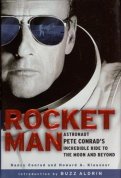 One of the interesting aspects of reading books about the Space Race and space exploration is discovering past space programmes that might have been. Perhaps in some alternative universe, they do indeed exist, the decisions which scuppered the projects in our history having gone differently. The Space Station by Kent Alexander is a relatively late – historically speaking – entry into this genre as it describes the plans and intentions of the US programme during the 1980s for a manned space outpost.
One of the interesting aspects of reading books about the Space Race and space exploration is discovering past space programmes that might have been. Perhaps in some alternative universe, they do indeed exist, the decisions which scuppered the projects in our history having gone differently. The Space Station by Kent Alexander is a relatively late – historically speaking – entry into this genre as it describes the plans and intentions of the US programme during the 1980s for a manned space outpost.
At that time, of course, the Soviet Union still existed and remained the West’s implacable foe. Indeed, The Space Station does not mention Salyut at all, names Mir only in passing, and incorrectly identifies Alan Shepard as “the first man to venture into space”. But then the book does read in place like more of a propaganda piece, declaring in the final chapter that “if the United States is to be the leader in improving the general well-being of humankind on Earth and in space beyond the twentieth century…” In the twenty-three years since the book was published, the USA can hardly be said to have successfully implemented that particular policy.
When The Space Station is not celebrating the US, it is celebrating NASA and its ambitions. NASA’s achievements are passed over quickly in an introductory chapter. The second chapter opens with Ronald Reagan’s State of the Union address of January 1984, and his call in it for “NASA to develop a permanently manned space station and do it within a decade” (the speech is not quoted in The Space Station), before discussing the numerous studies and reports on space stations put together by astronauts, scientists and administrators at NASA. The book is copiously illustrated – with artists’ impressions and mock-ups – of space station concepts by US aeronautical companies. One chapter is titled ‘International Participation’ and discusses the role the European Space Agency, Canada and Japan would play in the US space programme. No mention, of course, of Russia – despite the Apollo-Soyuz Test Project of thirteen years earlier. Much is made of the projected costs of the proposed space station – an initial estimate of $8 billion was revised upwards to $13 billion (and to $30 billion in 1989). With each new price-tag came a diminishment in the space station’s capabilities. It was these two factors which eventually led to the demise of the project. Incidentally, though the space station described by The Space Station is Space Station Freedom (as was), it was not given the name until June 1988, after the book was written.
Ironically, the International Space Station, which grew out of Space Station Freedom, has to date cost some $100 billion.
The Space Station describes an interesting might-have-been, which means it is of debatable usefulness as a history of the US space programme or US space stations. Its failure to look outside the USA also counts against it. While the illustrations in the book are interesting, the real world has turned too much of its contents into alternative history. This gives the book little more than curiosity value. A much better book on space stations is Roger D Launius’s Space Stations: Base Camps to the Stars (see here).
The Space Station, Kent Alexander (1988, Gallery Books, ISBN 0-8317-7940-3, 134pp + ‘Further Reading’ and index)


